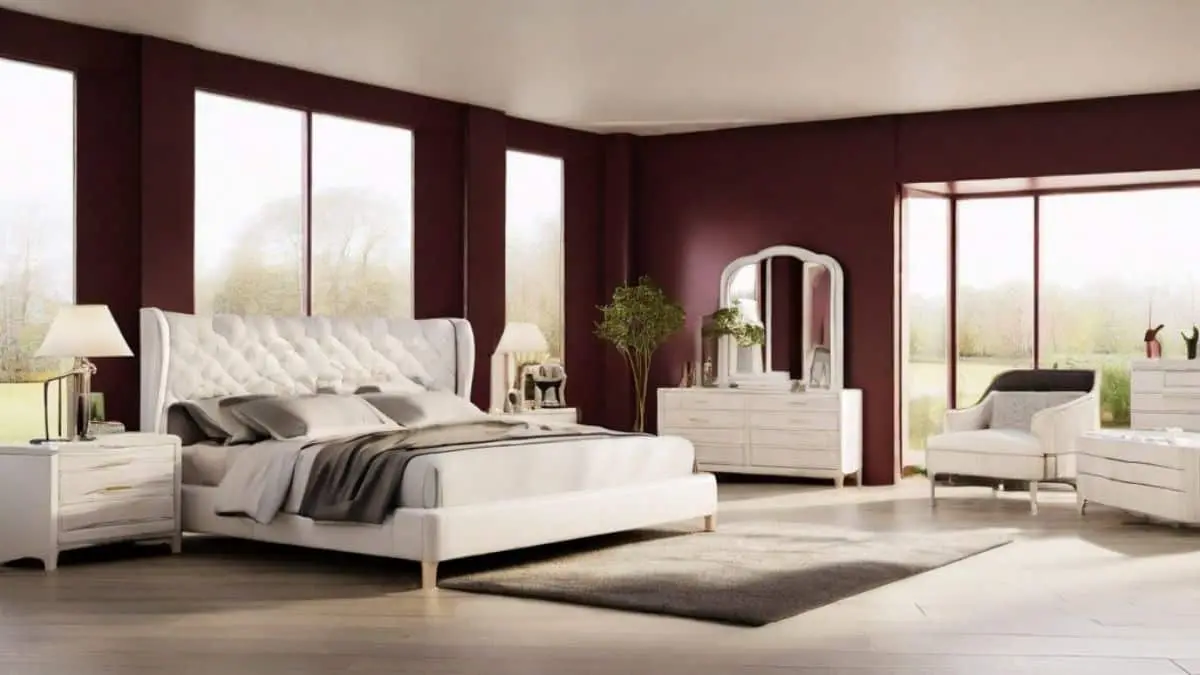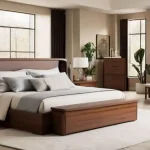When it comes to creating a bedroom that feels complete and well-put-together, choosing the right furniture is essential. Your bedroom should be a sanctuary—a place where you can relax, recharge, and feel at home.
But achieving that perfect balance of comfort and style often starts with picking the right pieces of furniture.We’ll walk you through the bedroom furniture essentials that will help you pull together a cohesive and inviting space.
Whether you’re starting from scratch or looking to refresh your current setup, understanding these key elements will guide you toward a bedroom that feels just right.
The Bed: The Focal Point of Your Bedroom
Let’s start with the star of the show—the bed. It’s the largest piece of furniture in the room and often sets the tone for the rest of your design. Whether you prefer a minimalist look or something more ornate, choosing the right bed frame and mattress is crucial for both aesthetics and comfort.
Choosing the Right Bed Frame
The bed frame is more than just a support for your mattress—it’s a statement piece. You’ve got options ranging from sleek platform beds that offer a low-profile look to classic sleigh beds with their curved headboards and footboards. If you’re tight on space, consider a storage bed, which combines style with functionality, providing hidden storage beneath the mattress.
When picking a bed frame, think about how it will fit with the rest of your bedroom furniture. For example, a canopy bed can add a touch of luxury and drama, but it might overwhelm a small room.
On the other hand, a simple metal frame might be too understated in a large, lavishly decorated space. The key is to choose a bed frame that not only matches your style but also fits the scale of your room.
Mattress Selection Tips
Comfort is king when it comes to mattresses. After all, a good night’s sleep starts with the right support. When choosing a mattress, consider factors like firmness, material, and size.
Are you a side sleeper who needs a softer mattress, or do you prefer a firmer feel for back support? Memory foam, latex, and innerspring are just a few of the options available, each offering a different sleep experience.
Size is another important consideration. A king-size bed might be perfect for a spacious master bedroom, while a queen or full-size mattress might better suit a smaller room. Remember, your mattress should fit comfortably within your bed frame, leaving enough room for other furniture like nightstands and dressers.
Bedside Tables: Functional and Stylish
No bed is complete without a pair of bedside tables—or at least one, if space is limited. Bedside tables provide a convenient spot for essentials like a lamp, alarm clock, or your favorite book.
When choosing bedside tables, consider the height relative to your mattress. Ideally, the table should be level with the top of your mattress or slightly lower, making it easy to reach for items while lying in bed.
Style-wise, your bedside tables should complement your bed frame and other furniture in the room. Whether you opt for matching tables or mix and match for a more eclectic look, ensure they provide enough storage for your needs—whether that’s a drawer for personal items or an open shelf for displaying décor.
Carefully selecting your bed, mattress, and bedside tables, you’re well on your way to creating a bedroom that’s not only functional but also beautifully styled. These bedroom furniture essentials lay the foundation for a space that feels complete, comfortable, and uniquely yours.
Storage Solutions: Dressers, Wardrobes, and Chests
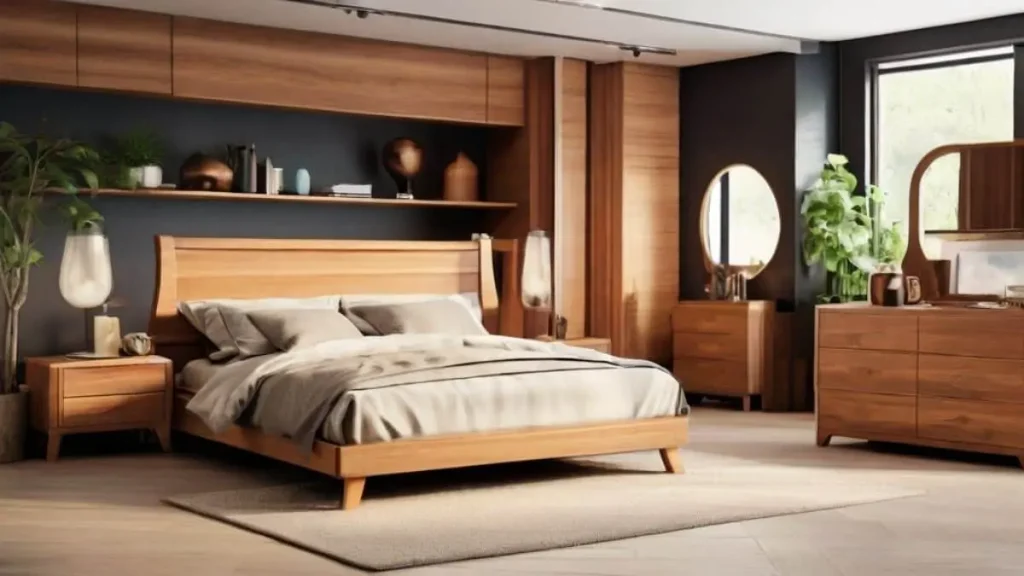
Creating a clutter-free and organized bedroom starts with the right storage solutions. Dressers, wardrobes, and chests not only provide essential storage but also contribute to the overall style and feel of your space. Let’s dive into how you can choose and use these bedroom furniture essentials to keep your room tidy and visually appealing.
Dressers: Combining Style and Storage
A dresser is a versatile piece of furniture that offers both storage and a surface for décor. When choosing a dresser, think about the size of your bedroom and your storage needs.
Vertical dressers, also known as tallboys, are great for maximizing space in smaller rooms, while horizontal dressers provide more surface area for decorative items like mirrors, plants, or picture frames.
Functionality is key, so look for a dresser with a mix of drawer sizes to accommodate everything from clothing to accessories. For a cohesive look, consider matching the dresser to your bed frame and other furniture.
However, don’t be afraid to mix different styles if you’re going for an eclectic vibe—just ensure there’s some element that ties the pieces together, such as color or material.
Wardrobes and Armoires
If your bedroom lacks built-in closets, a wardrobe or armoire can be a lifesaver. These pieces offer ample hanging space for clothes, along with additional storage for shoes, bags, and other accessories.
When selecting a wardrobe, consider the size of your room and the amount of storage you need. A larger wardrobe with multiple compartments can help keep everything organized, while a more compact armoire might be a better fit for a smaller space.
Style-wise, wardrobes and armoires come in a variety of designs, from sleek, modern pieces to more traditional, ornate options. Choose one that complements the overall aesthetic of your bedroom. For example, a rustic wooden wardrobe can add warmth to a cozy bedroom, while a mirrored armoire can make a small room feel larger and more open.
Chests of Drawers
Chests of drawers are similar to dressers but typically taller and narrower, making them perfect for smaller bedrooms or for adding extra storage to a larger room. A chest of drawers can be a standalone piece or part of a matching bedroom set, depending on your design preference.
When organizing your chest of drawers, consider using drawer dividers to keep smaller items like socks, underwear, or jewelry neatly separated. This not only helps maintain order but also makes it easier to find what you need quickly. Position the chest of drawers in a convenient location, such as near your bed or closet, so that it’s easy to access when getting dressed.
Seating: Adding Comfort and Functionality
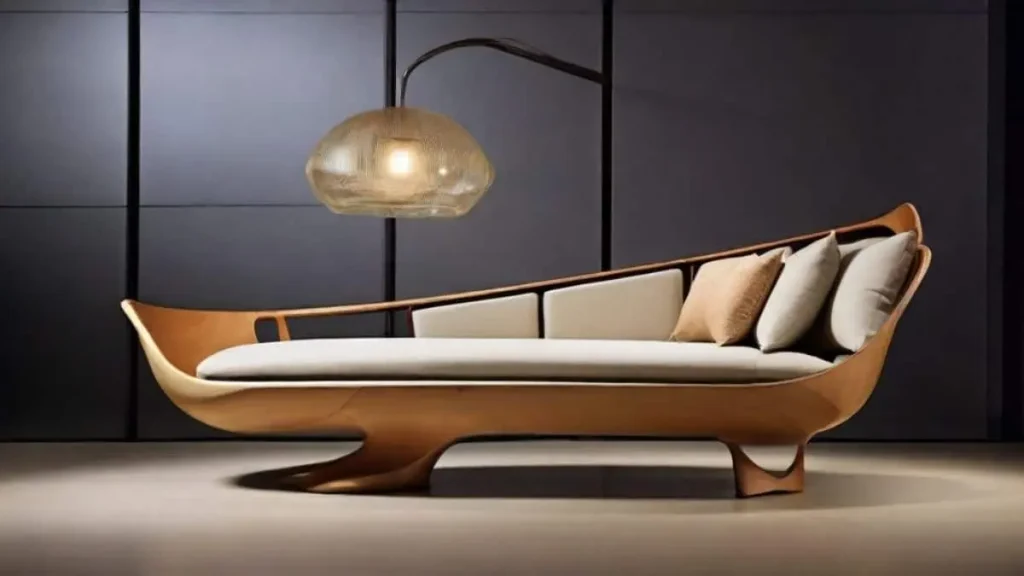
Seating may not be the first thing that comes to mind when you think about bedroom furniture essentials, but it plays a crucial role in adding both comfort and functionality to your space. Whether it’s a cozy reading nook, a stylish bedroom bench, or an accent chair, the right seating can make your bedroom more inviting and versatile.
Bedroom Benches
A bedroom bench is a versatile piece that can be placed at the foot of the bed, under a window, or in an empty corner. It provides extra seating when needed, and many benches also offer storage space, making them ideal for stowing away blankets, pillows, or even shoes.
When choosing a bedroom bench, consider both its size and style. A tufted bench with wooden legs can add a touch of elegance to a traditional bedroom, while a sleek, minimalist bench may better suit a modern or contemporary space. The key is to select a bench that complements the overall design of your bedroom and serves a practical purpose.
Accent Chairs
An accent chair can add a pop of color and personality to your bedroom while also providing a comfortable spot to sit and relax. Whether you place it in a reading nook, next to a window, or in a corner, an accent chair can serve as both a functional and decorative piece.
When choosing an accent chair, consider the available space and how the chair will be used. A plush, oversized chair with a matching ottoman can create a cozy reading corner, while a sleek, mid-century modern chair might be perfect for a more minimalist bedroom. The fabric and color of the chair should also complement the other furniture and décor in the room.
Ottomans and Footstools
Ottomans and footstools are small but mighty when it comes to adding comfort and functionality to your bedroom. They can serve as a place to rest your feet, extra seating, or even additional storage, depending on the design.
A storage ottoman can be particularly useful in smaller bedrooms where space is at a premium. You can use it to store extra bedding, books, or other items while also providing a comfortable spot to sit.
Choose an ottoman or footstool that matches your bedroom’s style—whether that’s a classic leather ottoman for a touch of luxury or a soft, upholstered footstool for a more casual, cozy feel.
Thoughtfully incorporating seating into your bedroom, you not only enhance the room’s comfort but also add to its overall functionality and style. These pieces, while often overlooked, are essential to creating a complete and inviting bedroom space.
Nightstands and Bedside Storage
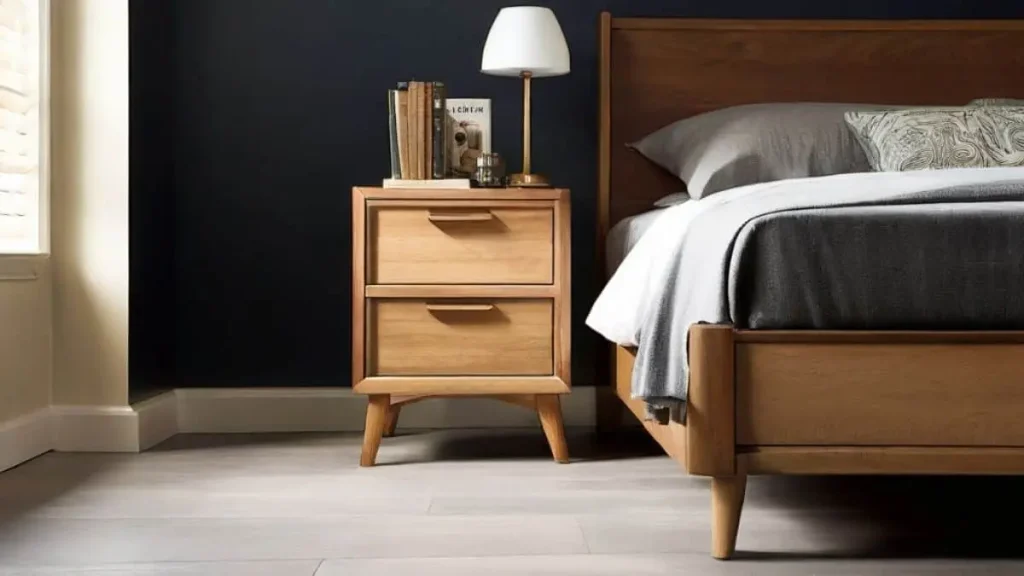
No bedroom is complete without a pair of nightstands or bedside tables. These small but mighty pieces of furniture provide the perfect spot for all your nighttime essentials, from lamps and alarm clocks to books and personal items.
But beyond their functionality, nightstands also contribute to the overall aesthetic of your bedroom, helping to frame your bed and create a balanced, cohesive look.
Choosing the Right Nightstands
When selecting nightstands, consider the style and size of your bed. Ideally, your nightstands should be at a height that’s level with or slightly below the top of your mattress, making it easy to reach for items while lying in bed.
The size of the nightstands should also be in proportion to your bed and the room itself; oversized nightstands can overwhelm a small bedroom, while tiny tables might look out of place in a larger space.
Style is another important factor. If your bed has a modern, minimalist design, opt for nightstands with clean lines and simple features.
For a more traditional look, consider nightstands with ornate detailing, curved legs, or rich wood finishes. Matching your nightstands to other pieces of furniture in the room, like your dresser or bed frame, can help tie the whole look together.
Maximizing Bedside Storage
While nightstands often have a drawer or two for small items, you might need additional storage space for things like books, electronics, or extra blankets. Consider nightstands with multiple drawers, shelves, or even a built-in charging station to keep your bedroom tidy and organized.
If space is limited, look for nightstands with hidden storage solutions, like pull-out trays or compartments. These features can help you keep clutter at bay without sacrificing style. Another option is to use floating shelves as bedside tables—these can be mounted at the perfect height and are great for small bedrooms where floor space is at a premium.
Decorating Your Nightstands
Once you’ve chosen your nightstands, it’s time to think about how to style them. Start with the essentials: a lamp for reading, a clock, and a small dish or tray for personal items like jewelry or glasses.
From there, add decorative touches that reflect your personality and tie in with the rest of your bedroom décor. A small plant, a stack of your favorite books, or a framed photo can add warmth and character to your nightstand without making it feel cluttered.
Wardrobe Essentials: Dressers, Closets, and Armoires
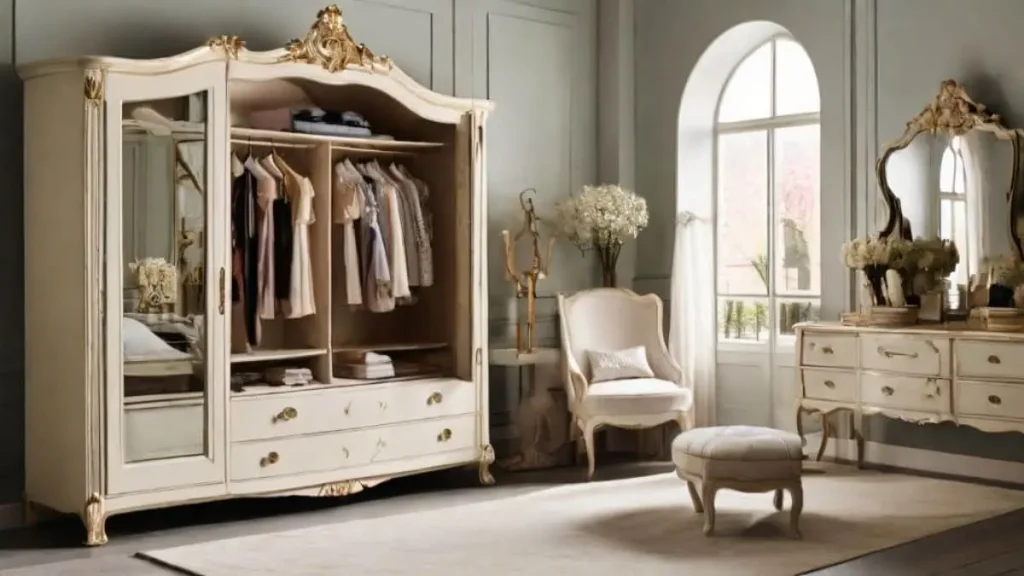
Organizing your clothing and accessories is key to maintaining a tidy and functional bedroom, and the right wardrobe furniture plays a big role in this. Whether you have a built-in closet or need standalone storage solutions, dressers, closets, and armoires are essential pieces that can help you keep everything in order.
Dressers: Practical and Stylish Storage
Dressers are a staple in most bedrooms, offering ample storage space for folded clothes, linens, and personal items. When choosing a dresser, consider the amount of storage you need and the layout of your bedroom.
A large dresser with multiple drawers is ideal for those with extensive wardrobes, while a smaller, more compact dresser might be perfect for a guest room or a smaller space.
The style of your dresser should complement the rest of your bedroom furniture. For a cohesive look, consider matching your dresser to your bed frame or nightstands. Alternatively, if you’re going for an eclectic vibe, you can mix different styles, as long as there’s some element—like color, material, or design—that ties the pieces together.
Closets: Built-In Versus Standalone Solutions
If you’re lucky enough to have a built-in closet, maximizing its potential is key to keeping your bedroom organized. Use a combination of hanging rods, shelves, and drawers to accommodate everything from clothing to shoes and accessories.
Closet organizers, such as bins, baskets, and hanging storage, can help you make the most of your space and keep things tidy.
For those without built-in closets, standalone wardrobes or armoires are excellent alternatives. These pieces offer a combination of hanging space and drawers, making them versatile and functional.
When choosing a wardrobe, consider your storage needs and the size of your room. A large armoire with multiple compartments can help you keep everything organized, while a more compact wardrobe might be better suited to a smaller space.
Armoires: Elegant and Functional
Armoires are a classic choice for bedroom storage, offering a touch of elegance along with practicality. These tall, often ornate pieces of furniture typically feature a combination of hanging space and drawers, making them ideal for storing everything from clothing to accessories.
When selecting an armoire, consider the style and scale of your bedroom. A large, traditional armoire with intricate detailing can serve as a statement piece in a spacious master bedroom, while a more streamlined, modern armoire might be better suited to a contemporary space.
Organizing Your Wardrobe
Once you’ve chosen your dressers, closets, or armoires, it’s time to organize them efficiently. Use drawer dividers in your dressers to separate smaller items like socks and underwear.
In your closet or wardrobe, hang similar items together—such as dresses, shirts, and pants—to make it easier to find what you need. Consider adding hooks inside your wardrobe doors for scarves, belts, or jewelry, keeping them easily accessible but out of sight.
Carefully selecting and organizing your wardrobe essentials, you can create a bedroom that’s not only stylish but also highly functional. These pieces of furniture help keep your space organized and clutter-free, making it easier to relax and enjoy your bedroom.
Mirrors: Functional and Decorative
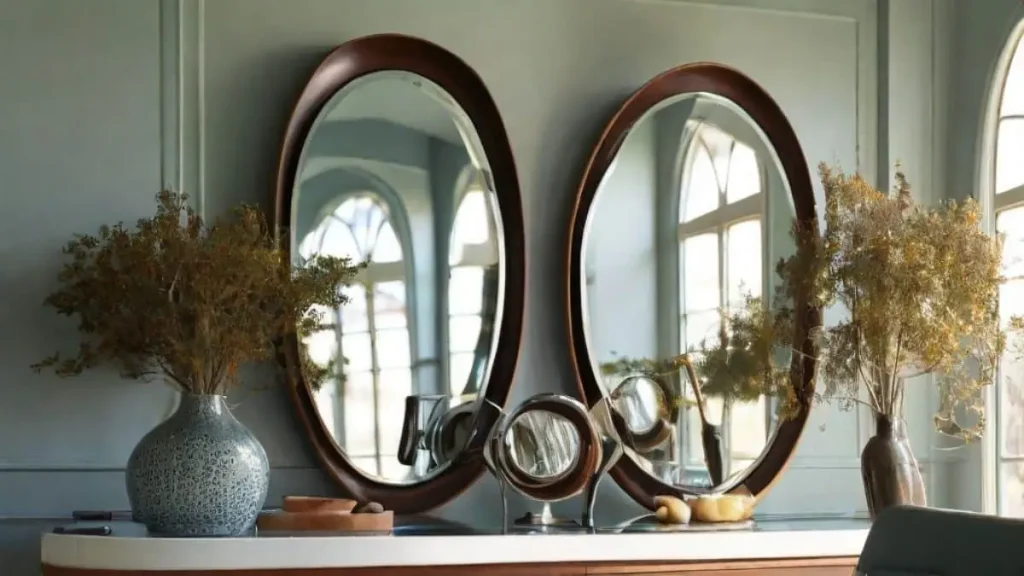
Mirrors are an essential yet often overlooked component of bedroom furniture. They serve a dual purpose—adding both functionality and a touch of style to your space. Whether you’re using them for practical purposes or as decorative accents, mirrors can significantly enhance your bedroom’s look and feel.
Enhancing Space and Light
One of the most significant benefits of adding mirrors to your bedroom is their ability to make the space appear larger and brighter. By reflecting light, mirrors can create an illusion of depth, which is particularly beneficial in smaller rooms. Placing a large mirror opposite a window can amplify natural light, making your bedroom feel more open and airy.
Even in larger bedrooms, mirrors can add a sense of balance and harmony. Consider a full-length mirror near your wardrobe or dresser, which is perfect for outfit checks, or a stylish wall mirror above your bed or dresser to add visual interest.
Choosing the Right Style
When selecting mirrors for your bedroom, consider the overall design and aesthetic of your space. If your bedroom has a modern, minimalist vibe, opt for sleek, frameless mirrors or those with simple metal frames.
For a more traditional or rustic look, wooden frames with intricate detailing can add warmth and character.
The shape of the mirror also plays a role in the overall design. Round mirrors can soften the lines in a room and add a contemporary feel, while rectangular or square mirrors offer a more classic, structured look.
Decorative mirrors with unique shapes or artistic frames can serve as statement pieces, drawing attention and adding personality to your bedroom.
Practical Placement Tips
Where you place your mirrors can impact both their functionality and their effect on the room’s ambiance. A full-length mirror should be positioned in a spot where you can easily view your entire outfit, like near your closet or beside a dresser.
Wall mirrors can be hung above dressers, nightstands, or even on an accent wall to reflect light and enhance the room’s décor.
For a more creative approach, consider grouping smaller mirrors together to create a gallery wall. This not only adds a decorative element but also helps bounce light around the room, contributing to a brighter, more inviting atmosphere.
Additional Touches: Accessories and Décor
While the main pieces of furniture set the foundation for your bedroom, it’s the accessories and décor that truly bring the space to life. These finishing touches add personality, warmth, and a sense of completeness to your room, making it a true reflection of your style.
Choosing the Right Accessories
When it comes to accessorizing your bedroom, think about items that are both beautiful and functional. Throw pillows, blankets, and rugs can add color, texture, and comfort to your space. Choose soft, cozy fabrics for a warm and inviting feel, or go for bold patterns and vibrant colors to make a statement.
Lamps and lighting fixtures are another crucial element. Bedside lamps not only provide essential task lighting but also add to the room’s aesthetic. Opt for lamps that complement your bedroom’s style—whether it’s sleek and modern, vintage-inspired, or rustic and earthy.
Incorporating Personal Touches
Your bedroom should be a reflection of your personal tastes and experiences. Incorporate items that tell your story, such as framed photos, artwork, or mementos from your travels. These personal touches add character and make the space uniquely yours.
Consider adding a few pieces of wall art that resonate with you, whether it’s a serene landscape, an abstract piece, or a gallery of family photos. Decorative trays or bowls on your dresser can hold jewelry, keys, or other small items while adding a layer of elegance.
Creating a Cohesive Look
While it’s easy to get carried away with accessories, it’s important to maintain a cohesive look throughout your bedroom. Choose a color palette and stick to it when selecting accessories and décor items.
This ensures that everything works together harmoniously, rather than clashing or overwhelming the space.
Balance is key—avoid overcrowding surfaces or walls with too many items. Instead, choose a few standout pieces that add interest and complement the room’s overall design. This approach creates a serene, organized environment that’s conducive to relaxation.
Recommended Post: How to Arrange Bedroom Furniture
Practical Tips for Choosing Bedroom Furniture

Selecting the right bedroom furniture can be both exciting and daunting. With so many styles, sizes, and materials to choose from, it’s easy to feel overwhelmed. However, by keeping a few practical tips in mind, you can make the process smoother and ensure you end up with pieces that you love and that work well in your space.
Measure Your Space
Before you start shopping for bedroom furniture, it’s essential to measure your space. This includes the dimensions of the room itself, as well as the size of any existing furniture you plan to keep. Make a rough sketch of your bedroom layout, noting the location of doors, windows, and any architectural features that might affect where you can place furniture.
Knowing your room’s dimensions will help you choose furniture that fits well and doesn’t overcrowd the space. For example, if you have a smaller bedroom, a king-sized bed might not be practical, while a queen or full-sized bed could be a better fit.
Similarly, a large dresser might dominate the room, whereas a taller, narrower chest of drawers could provide ample storage without taking up too much floor space.
Prioritize Functionality
While aesthetics are important, functionality should be your top priority when choosing bedroom furniture essentials. Think about how you use your bedroom and what pieces are necessary to make the space work for you.
For example, if you love to read in bed, a comfortable chair or a bed with an adjustable headboard could be worthwhile investments. If storage is a concern, look for multifunctional furniture like a bed with built-in drawers or a nightstand with ample storage.
Consider how each piece of furniture will serve your daily routine. A spacious dresser with a mirror on top might make your morning routine more convenient, while a bench at the foot of the bed can provide a place to sit while putting on shoes or storing extra blankets.
Choose a Cohesive Style
To create a harmonious look, aim for a cohesive style throughout your bedroom. This doesn’t mean that all your furniture has to match perfectly, but there should be a unifying element, such as color, material, or design. For example, if your bed frame has a rustic, wooden finish, you might choose nightstands and dressers with similar wood tones or textures.
If you prefer an eclectic style, mix and match furniture with complementary features. For example, you might pair a modern bed frame with vintage-inspired nightstands, as long as there’s a common thread, like a similar color palette or material. A cohesive style helps create a serene and visually pleasing environment, making your bedroom a relaxing retreat.
Invest in Quality Pieces
Bedroom furniture is an investment, so it’s worth spending a little more on quality pieces that will last. Look for furniture made from durable materials, such as solid wood or metal, and check the craftsmanship. Well-made furniture not only looks better but also withstands daily wear and tear, providing you with comfort and functionality for years to come.
If your budget is limited, prioritize key pieces like the bed and dresser. You can always add or upgrade other items later. Quality furniture also tends to be more comfortable, making your bedroom a more enjoyable place to spend time.
Common Mistakes to Avoid When Furnishing a Bedroom
Furnishing a bedroom involves more than just picking out furniture that looks good. It requires thoughtful planning and consideration to avoid common pitfalls that can lead to a cluttered, uncomfortable, or mismatched space. Here are some mistakes to watch out for—and how to avoid them.
Overcrowding the Room
One of the most common mistakes people make is overcrowding their bedroom with too much furniture. It’s tempting to fill every corner with something, but this can make your room feel cramped and cluttered. Remember that less is often more when it comes to bedroom design.
To avoid this mistake, start by identifying the essential furniture pieces—such as the bed, dresser, and nightstands—and arrange them in your room. If you have extra space, you can then consider adding additional items like a chair, bench, or vanity. However, always ensure there’s enough space to move around comfortably and that the room feels open and inviting.
Ignoring Scale and Proportion
Another common mistake is choosing furniture that’s either too large or too small for the room. Oversized furniture can overwhelm a small bedroom, while tiny pieces might look lost in a larger space. It’s important to consider the scale and proportion of each item relative to your room’s size.
Before purchasing, measure both the furniture and your bedroom to ensure everything will fit well. For example, if you have a large bed, balance it with appropriately sized nightstands and dressers. If your room is on the smaller side, opt for furniture with a lighter visual footprint, such as pieces with legs rather than solid bases.
Neglecting Storage Needs
A beautiful bedroom can quickly become a source of stress if it lacks adequate storage. Clutter can accumulate on surfaces and floors, making the room feel chaotic and disorganized. It’s crucial to consider your storage needs when choosing bedroom furniture essentials.
To avoid this mistake, opt for furniture that offers built-in storage, such as beds with drawers underneath, nightstands with multiple drawers, or wardrobes with both hanging space and shelving. Additionally, consider adding storage accessories like baskets, bins, or drawer dividers to maximize the functionality of your furniture.
Choosing Style Over Comfort
While it’s important to have a stylish bedroom, comfort should never be sacrificed. Choosing a bed, chair, or mattress that looks great but is uncomfortable can lead to sleepless nights and a bedroom that you don’t enjoy spending time in.
Always prioritize comfort when selecting key pieces like your bed and seating. Test out mattresses, sit in chairs, and consider how you’ll use each item daily. A comfortable bedroom is essential for relaxation and well-being, so make sure your furniture supports a restful environment.
Forgetting About Lighting
Lighting is a crucial aspect of bedroom design, yet it’s often overlooked when furnishing a room. Relying solely on overhead lighting can create a harsh, uninviting atmosphere, while neglecting task lighting can make activities like reading or getting dressed difficult.
To avoid this mistake, incorporate a variety of lighting sources in your bedroom. Bedside lamps are essential for reading and creating a cozy ambiance, while floor lamps or sconces can provide additional illumination.
Dimmer switches can also help you adjust the lighting to suit different moods and times of day.
Being mindful of these common mistakes and following practical tips, you can create a bedroom that is not only stylish but also functional, comfortable, and well-organized.
This approach ensures that your space remains a restful retreat that meets your needs and reflects your personal style.
Conclusion
Creating a bedroom that feels complete and inviting is all about selecting the right furniture essentials. From the bed, which serves as the room’s focal point, to practical storage solutions, seating, and decorative accents, each piece plays a vital role in shaping the overall look and functionality of the space.
By carefully considering your needs, preferences, and the layout of your room, you can create a cohesive and stylish environment that truly reflects your personality.
Remember, the key to a well-furnished bedroom is balance. Prioritize comfort and functionality while also paying attention to style and cohesion.
Avoid common pitfalls like overcrowding, neglecting storage, or choosing aesthetics over comfort. With thoughtful planning and a focus on quality, you can create a bedroom that not only looks great but also serves as a relaxing retreat where you can unwind and recharge.
Whether you’re starting from scratch or simply updating a few pieces, the right bedroom furniture essentials can transform your space into a sanctuary that you’ll love coming home to every day. Happy decorating!

